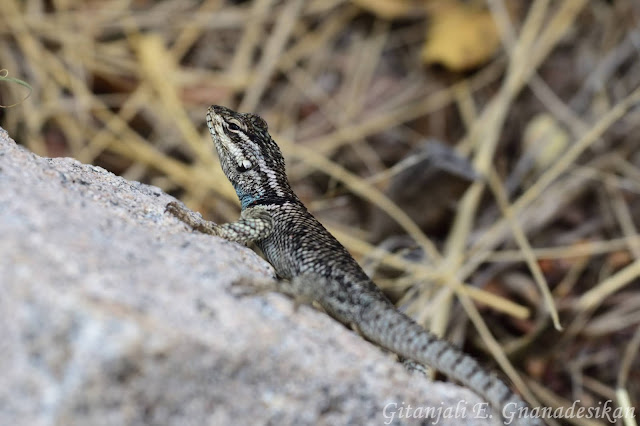Last week I took a hike in Madera Canyon, a lovely spot in
the Santa Rita mountains, south of Tucson. Between one thing and another (read: comps, pandemic, revision deadlines, the Bighorn Fire, and the Tucson heat), I hadn't gotten out for a hike in a while, and it was everything I needed it to be.
The Santa Rita Mountains are home to Mt. Wrightson, which at at 9,456 ft (2,882 m) is a few hundred ft taller than Mt. Lemmon, making it the tallest of the many mountains surrounding Tucson.
I didn't go all the way to the top, though; I took a more leisurely hike instead, stopping frequently to take photos, especially of all the wildlife. I did the 6.2 mile
Josephine Saddle Loop: starting from the Mt. Wrightson Picnic area and taking the not-so-steep Super Trail up to Josephine Saddle, then the significantly steeper Old Baldy Trail back down. There were some lovely views of both the mountains and the valley, and I definitely look forward to going back soon (and maybe sometime going all the way to the top too).
I love the way you can see the green stripes of the riparian vegetation radiating away from the mountains into the much drier desert.
It was a lovely day, cool--sub-80s, with some help from the elevation--and some rain in the morning but the sun soon shone through. (And in Arizona, rain is a treat!)
Madera Canyon is famous for its birds. I heard many, spotted some, and got decent shots of just a few. But there were countless more flitting by and singing all around me. This Mexican jay (
Aphelocoma wollweberi) was the first sighting, sitting right near the trail head. I didn't notice at the time, but it's carrying not one but two acorns! It took flight just a moment later, maybe
going off to cache them somewhere?
Speaking of acorns, this is a female acorn woodpecker (
Melanerpes formicivorus).
Acorn woodpeckers cache thousands of acorns a year in holes that they make in trees.
This is a female Arizona woodpecker (
Dryobates arizonae), identified by the lack of the typical woodpecker black and red patterning.
And here's a pair of them. It was fun to see the two of them moving through the trees together.
My favorite bird of the hike was this brown creeper (
Certhia americana). Its tree-clinging behavior is reminiscent of woodpeckers, but the body shape is quite distinctive. The brown creeper is the only species of its family that is present in North America, although it is very widespread here.
Because I liked it so much, you get two photos of this one. Isn't it cute? And look at its tiny feet clinging to the tree bark,
This one is a yellow-eyed junco (
Junco phaeonotus), which is native to southern Arizona and Mexico and differs from the much more widespread dark-eyed junco by its--you guessed it--yellow eyes. There were many of these about, mostly picking through the leaf litter for seeds, insects, or arachnids to eat.
The flash of bright red on this painted redstart (
Myioborus pictus) caught my attention immediately. It sat there preening for a moment, feathers all ruffled, before flying off out of sight.
This black-throated gray warbler (
Setophaga nigrescens) has distinctive yellow forehead patches. These warblers fly south to Mexico for the winter, but they're apparently pretty common here in the spring and summer (breeding season).
One of bird species I saw
and heard most on this hike was the bridled titmouse (
Baeolophus wollweberi). This one clearly had something to say to its friend.
And now for the lizards. There were so many lizards. Actually, I have so many lizard photos, there might be a later blog post dedicated just to them and their interesting biology. But here are a few sneak peaks.
Mostly there were a very large number of Yarrow's spiny lizard (
Sceloporus jarrovii), distinguished from the other local spiny lizards by the black collar encircling the entire neck, and not just the throat.
I think this one, though, is a desert spiny lizard (
Sceloporus magister) since it lacks both the full collar and the banded forelimbs of the Clark's spiny lizard.
I also saw quite a variety of butterflies, including a few gorgeous, large, yellow swallowtails that I sadly didn't get any photos of. But here's what I did catch. I believe these are both red satyrs (
Megisto rubricata), although you might not guess from the ventral and dorsal wing sides that they were the same (
a common effect in butterflies).
This one is some kind of azure (
Celastrina); there was a whole swarm of them near "Sprung Spring" where there was a tiny bit of water.
And this little one had seen better days, and I don't know what species it is.
And this one is actually a diurnal moth, I think a veined ctenucha (
Ctenucha venosa). Note the feathery rather than clubbed antennae and the wing positioning (hence, moth, not butterfly).
This pretty male damselfly is probably a dancer (
Argia), but I'm not even going to try to venture a species (hey, insects are hard!). Similar to moths and butterflies, the way the wings are held closed like this marks him as a damselfly rather than a dragonfly. His coloration was eye-catching and the biggest clue contributing to my guess of a genus; it also tells me he is male, as the females are brown and therefore much harder to spot.
Well that's all for now. I hope I haven't bored you with all those species! The sky islands are
such interesting and diverse ecosystems, and I need to make it out (and up) there more often. I'll be back with more lizards--and maybe more of the flora--soon.




































































